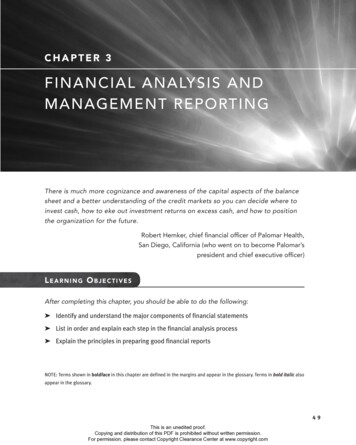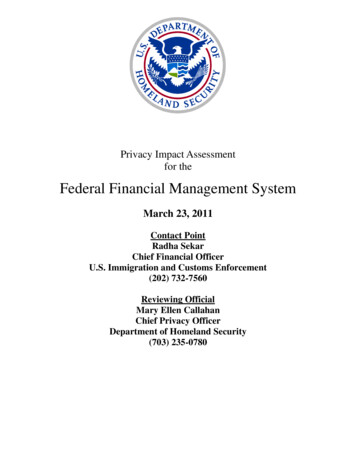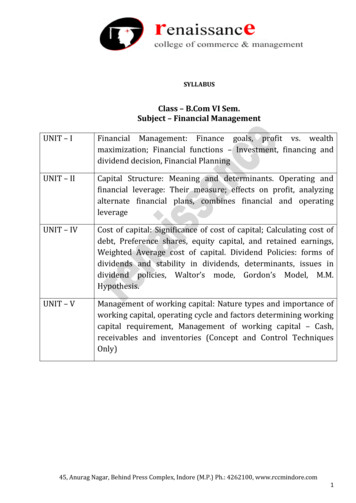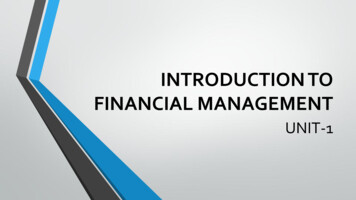
Transcription
Fully supported by a comprehensiverange of student and lecturer learningresources, Financial Managementfor Decision Makers is ideal forundergraduates from a non-finance/accounting discipline taking anintroductory module in financialmanagement, and postgraduate/postexperience students on coursessuch as the ACCA Diploma in FinancialManagement, Diploma in ManagementStudies and MBA programmes. Thetext is also suitable for finance andaccounting students as a foundationfor further study.Key features: Written in a unique, ‘open learning’ style Clear explanations and minimal technicaljargon to aid understanding – no previousknowledge of financial management isassumed Based on a solid foundation of theory,but focusing throughout on its value fordecision making Covering all the main areas of financialmanagement in sufficient detail to providea good grasp of the subject Numerous examples, activities andexercises throughout, allowing the readerto test his/her knowledge at frequentintervalsCVR ATRI7645 05 SE CVR.indd 1Front cover image: Alamy ImagesFinancialManagementfor Decision MakersFifth EditionPeter AtrillFifthEditionAtrillPeter Atrill is a freelance academic and author working with leading institutionsin the UK, Europe and SE Asia. He has previously held posts as Head ofBusiness and Management and Head of Accounting and Law at University ofPlymouth Business School.an imprint ofFinancial ManagementNew to this edition: Expanded coverage of key topics suchas financing the business Increased coverage of corporategovernance issues Even more real-world examples to helpillustrate the practical application andimportance of the topics discussed Financial statements throughout basedon the latest International AccountingStandards Full-colour design, packed withpedagogical features, providing anoriginal learning experiencefor Decision MakersAdopting an innovative, open-learning approach to introduce the main principles of financial managementin an accessible, non-technical way, this fully updated fifth edition provides a unique focus on the practicalapplication of financial management and its role in decision making.www.pearson-books.com10/9/08 10:48:32
FINM A01.qxd10/23/089:20 AMPage iFinancial Managementfor Decision MakersVisit the Financial Management for Decision Makers, fifth edition,Companion Website at www.pearsoned.co.uk/atrillmclaney to findvaluable student learning material including:nnnnnnnLearning outcomes for each chapterMultiple choice questions to test your learningSolutions to end of chapter review questionsRevision questions to help you check your understandingExtensive links to valuable resources on the webAn online glossary to explain key termsFlashcards to test your knowledge of key terms and definitions
FINM A01.qxd10/23/089:20 AMPage iiWe work with leading authors to develop thestrongest educational materials in business and finance,bringing cutting-edge thinking and bestlearning practice to a global market.Under a range of well-known imprints, includingFinancial Times Prentice Hall, we craft high-quality print andelectronic publications which help readers to understandand apply their content, whether studying or at work.To find out more about the complete range of ourpublishing, please visit us on the World Wide Web at:www.pearsoned.co.uk
FINM A01.qxd10/23/089:20 AMPage iii5thEditionFinancial Managementfor Decision MakersPeter Atrill
FINM A01.qxd10/23/089:20 AMPage ivPearson Education LimitedEdinburgh GateHarlowEssex CM20 2JEEnglandand Associated Companies throughout the worldVisit us on the World Wide Web at:www.pearsoned.co.ukFirst published 1997Second edition published 2000Third edition published 2003Fourth edition published 2006Fifth edition published 2009 Prentice Hall Europe 1997 Pearson Education Limited 2000, 2009The right of Peter Atrill to be identified as author of this work has been asserted byhim in accordance with the Copyright, Designs and Patents Act 1988.All rights reserved. No part of this publication may be reproduced, stored in aretrieval system, or transmitted in any form or by any means, electronic, mechanical,photocopying, recording or otherwise, without either the prior written permission of thepublisher or a licence permitting restricted copying in the United Kingdom issued by theCopyright Licensing Agency Ltd, Saffron House, 6–10 Kirby Street, London EC1N 8TS.All trademarks used herein are the property of their respective owners. The use of anytrademark in this text does not vest in the author or publisher any trademark ownership rightsin such trademarks, nor does the use of such trademarks imply any affiliation with orendorsement of this book by such owners.ISBN: 978-0-273-71764-5British Library Cataloguing-in-Publication DataA catalogue record for this book is available from the British LibraryLibrary of Congress Cataloging-in-Publication DataAtrill, Peter.Financial management for decision makers / Peter Atrill. — 5th ed.p. cm.Includes bibliographical references and index.ISBN 978-0-273-71764-5 (pbk. : alk. paper) 1. Accounting. 2. Decision making.I. Title.HF5635.A8846 2009658.15—dc22200803720510 9 8 7 6 5 4 3 2 112 11 10 09 08Typeset in 9.5/12.5pt Stone Serif by 35Printed and bound by Graficas Estella, Navarro, SpainThe publisher’s policy is to use paper manufactured from sustainable forests.
FINM A01.qxd10/23/089:20 AMPage vFor Simon and Helen
FINM A01.qxd10/23/089:20 AMPage vi
FINM A01.qxd10/23/089:20 AMPage viiContentsPrefaceAcknowledgementsHow to use this bookGuided tour of the bookGuided tour of the Companion Website12xivxvixviiixxxxiiThe world of financial management1IntroductionLearning outcomes11The finance functionStructure of the bookModern financial managementWhy do businesses exist?Balancing risk and returnBehaving ethicallyProtecting shareholders’ interestsShareholder involvement244611121517SummaryKey termsReferencesFurther readingReview questions2526262627Financial planning29IntroductionLearning outcomes2929Planning for the futureThe role of projected financial statementsPreparing projected financial statementsPreparing the projected statements: a worked exampleProjected cash flow statementProjected income statementProjected statement of financial position (balance sheet)Projected financial statements and decision makingPer-cent-of-sales methodTaking account of risk30303238394244454952SummaryKey terms5758
FINM A01.qxdviii10/23/089:20 AMPage viiiCONTENTS34Further readingReview questionsExercises585959Analysing and interpreting financial statements67IntroductionLearning outcomes6767Financial ratiosFinancial ratio classificationsThe need for comparisonCalculating the ratiosA brief overviewProfitabilityEfficiencyRelationship between profitability and efficiencyLiquidityFinancial gearingInvestment ratiosFinancial ratios and the problem of overtradingTrend analysisUsing ratios to predict financial failureLimitations of ratio y termsReferencesFurther readingReview questionsExercises110111111112113113Making capital investment decisions121IntroductionLearning outcomesThe nature of investment decisionsInvestment appraisal methodsAccounting rate of return (ARR)Payback period (PP)Net present value (NPV)Why NPV is betterInternal rate of return (IRR)Some practical pointsInvestment appraisal in practiceThe process of investment decision makingInvestment decisions and human behaviourSummaryKey termsReferencesFurther readingReview 1155160161162162163164164
FINM A01.qxd10/23/089:20 AMPage ixCONTENTS56Making capital investment decisions:further issues171IntroductionLearning outcomes171171Investment decisions when funds are limitedComparing projects with unequal livesThe ability to delayThe problem of inflationThe problem of riskSensitivity analysisScenario analysisSimulationsRisk preferences of investorsRisk-adjusted discount rateExpected net present valueEvent tree diagramsRisk and the standard deviationThe standard deviation and the normal distributionThe expected value–standard deviation rulesMeasuring probabilitiesPortfolio effects and risk 5206206207SummaryKey termsReferencesFurther readingReview questionsExercises214216216216217217Financing a business 1: sourcesof finance221IntroductionLearning outcomes221221Sources of financeExternal sources of financeExternal sources of long-term financeExternal sources of short-term financeLong-term versus short-term borrowingInternal sources of financeInternal sources of long-term financeInternal sources of short-term finance222222223243247249249251SummaryKey termsFurther readingReview questionsExercises255256256257257ix
FINM A01.qxdx10/23/089:20 AMPage xCONTENTS789Financing a business 2: raising long-term finance261IntroductionLearning outcomes261261The Stock ExchangeStock market efficiencyAre the stock markets really efficient?Share issuesLong-term finance for the smaller businessBusiness angelsGovernment assistanceAlternative Investment Market (AIM)Amazon.com: a case history262268275277285296296297298SummaryKey termsReferencesFurther readingReview questionsExercises299301301301302302The cost of capital and the capitalstructure decision307IntroductionLearning outcomes307307Cost of capitalWeighted average cost of capital (WACC)Specific or average cost of capitalLimitations of the WACC approachCost of capital – some evidenceFinancial gearingDegree of financial gearingGearing and capital structure decisionsConstructing a PBIT–EPS indifference chartWhat determines the level of gearing?The capital structure debate308321324325326327330333337340342SummaryKey termsReferencesFurther readingReview questionsExercises351352353353354354Developing a dividend policy363IntroductionLearning outcomes363363Payment of dividendsDividend policies in practice364366
FINM A01.qxd10/23/089:20 AMPage xiCONTENTSDividend policy and shareholder wealthThe importance of dividendsFactors determining the level of dividendsDividend policy and management attitudes: some evidenceDividend smoothing in practiceWhat should managers do?Alternatives to cash dividends368373376381384385385SummaryKey termsReferencesFurther readingReview questionsExercises38838938938939039010 Managing working capital393IntroductionLearning outcomes393393The nature and purpose of working capitalThe scale of working capitalManaging inventoriesManaging receivablesManaging cashManaging trade payables394395398407417424SummaryKey termsFurther readingReview questionsExercises42642842943043011 Measuring and managing for shareholder value435IntroductionLearning outcomes435435The quest for shareholder valueCreating shareholder valueThe need for new forms of measurementNet present value (NPV) analysisManaging the business with shareholder value analysisImplications of SVAEconomic value added (EVA )EVA and SVA comparedEVA or SVA?EVA in practiceMarket value added (MVA)The link between MVA and EVA Limitations of MVATotal shareholder returnCriticisms of the shareholder value approachMeasuring the value of future 2463xi
FINM A01.qxdxii10/23/089:20 AMPage xiiCONTENTSImplementing the shareholder value approach464SummaryKey termsReferencesFurther readingReview questionsExercises46546746746746846812 Business mergers and share valuation473IntroductionLearning outcomes473473Mergers and takeoversMergers and takeover activityThe rationale for mergersForms of purchase considerationWho benefits?Why do mergers occur?Ingredients for successful mergersRejecting a takeover bidRestructuring a business: divestments and demergersThe valuation of sharesValuing a newly established business: an exampleChoosing a valuation y termsReferencesFurther readingReview questionsExercises516518518518519519AppendicesA Present value tableB Annual equivalent factor tableC Solutions to self-assessment questionsD Solutions to review questionsE Solutions to selected exercisesGlossary of key termsIndex527528529539549574584
FINM A01.qxd10/23/089:20 AMPage xiiiSupporting resourcesVisit www.pearsoned.co.uk/atrillmclaney to find valuable online resourcesCompanion Website for studentsn Learning outcomes for each chaptern Multiple choice questions to test your learningn Solutions to end of chapter review questionsn Revision questions to help you check your understandingn Extensive links to valuable resources on the webn An online glossary to explain key termsn Flashcards to test your knowledge of key terms and definitionsFor instructorsn Complete, downloadable Instructor’s manualn PowerPoint slides that can be downloaded and used as OHTsn Progress tests, consisting of various questions and exercise material withsolutionsn Tutorial/seminar questions and solutionsn Solutions to individual chapter exercisesAlso: The Companion Website provides the following features:nnnSearch tool to help locate specific items of contentE-mail results and profile tools to send results of quizzes to instructorsOnline help and support to assist with website usage and troubleshootingFor more information please contact your local Pearson Education salesrepresentative or visit www.pearsoned.co.uk/atrillmclaney
FINM A01.qxd10/23/089:20 AMPage xivPrefaceThis book has been written for those who wish to achieve a broad understanding offinancial management at either undergraduate or postgraduate/post-experience level.It is aimed primarily at students who are not majoring in financial management butwho, nevertheless, are studying introductory-level financial management as part of theircourse in business, management, economics, computing, engineering or some otherarea. Students who are majoring in financial management should, however, find thebook useful as an introduction to the main principles which can serve as a foundationfor further study. The book should also be suitable for those who are not following aparticular course but nevertheless need an understanding of financial management tohelp them manage their business.As there are several excellent books on financial management already published,you may wonder why another book is needed in this area. A problem with many booksis that they are too detailed and demanding to provide a suitable introduction to thesubject. They are often around a thousand pages in length and contain mathematicalformulae that many find daunting. This book assumes no previous knowledge of financial management (although a basic understanding of financial statements is required)and is written in an accessible style. Each topic is introduced carefully and there is agradual building of knowledge. In addition, mathematical formulae have been kept toa minimum.The book rests on a solid foundation of theory but the main focus throughout is itspractical value. It is assumed that readers are primarily concerned with understandingfinancial management in order to make better financial decisions. The title of the bookreflects this decision-making focus.The book is written in an ‘open learning’ style. That is, it tries to involve you in away not traditionally found in textbooks. Throughout each chapter there are activitiesand self-assessment questions for you to attempt. The purpose of these is to helpcheck understanding of the points that are being made and to encourage you to thinkaround particular topics. More detail concerning the nature and use of these activitiesand self-assessment questions is given in the ‘How to use this book’ section followingthis preface. The open learning style has been adopted because, I believe, it is more‘user friendly’. Irrespective of whether you are using the book as part of a taught courseor for independent study, the interactive approach employed makes it easier for youto learn.I recognise that most of you will not have studied financial management before andso I have tried to minimise the use of technical jargon. Where technical terminologyis unavoidable, I try to provide clear explanations. To help you further, all the key termsare highlighted in the book and then listed at the end of each chapter with a pagereference to help you rapidly revise the main concepts. All these key terms are listedalphabetically with a short definition in the glossary, which can be found towards theend of the book.
FINM A01.qxd10/23/089:20 AMPage xvPREFACEIn writing the fifth edition, I have taken account of helpful comments and suggestionsmade by lecturers, students and other readers. Many areas have been revised to improvethe clarity of the writing and I have introduced more diagrams and graphs to aidunderstanding. The number of real world exhibits has been increased to help illustratethe practical application and importance of the topics discussed.I do hope that you will find the book readable and helpful.Peter AtrillApril 2008xv
FINM A01.qxd10/23/089:20 AMPage xviAcknowledgementsI wish to acknowledge the generosity of the ACCA for allowing me to use extracts fromarticles that I wrote for Finance Matters magazine.Publisher’s acknowledgementsWe are grateful to the following for permission to reproduce copyright material:Figure 3.5 from Beaver, W.H. (1966) Financial ratios as predictors of failure, EmpiricalResearch in Accounting: Selected Studies, supplement to Journal of Accounting Research,Blackwell Publishers Limited; Real World 3.9 from Marks and Spencer Group plc AnnualReport 2007; Real World 5.1 from Arnold, G.C. and Hatzopoulos, P.D. (2000) The theorypractice gap in capital budgeting: evidence from the United Kingdom, Journal of BusinessFinance and Accounting, 27(5) and (6), Blackwell Publishers Limited; Real World 6.5 fromCorporate Finance: A valuation approach, Benninga, S.Z. and Sarig, O.H. (1997) The McGrawHill Companies, Inc.; Figure 7.3 from Reading the signs, The Independent The Independent2004; Figure 7.6 from The venture capital vacuum in Management Today, (Van der Wayer,M. 1995); Real World 7.14 from Angel Investing: Matching Start-up Funds with Start-upCompanies – A Guide for Entrepreneurs and Individual Investors, Jossey Bass, Inc., (VanOsnabrugge, M. and Robinson, R. J. 2000); Figure 8.6 from Graham, J. and Harvey, C. (2002)How do CFOs make capital budgeting and capital structure decisions?, Journal of AppliedCorporate Finance, Vol. 15, No. 1, Blackwell Publishers Limited; Figures 8.7 and 8.8 fromMcLaney, E., Pointon, J., Thomas, M. and Tucker, J. (2004) Practitioner’s perspectives onthe UK cost of capital, European Journal of Finance, 10, pp. 123–138, April; Figure 9.4 fromRevisiting managerial perspectives on dividend policy in Journal of Economics and Finance,Springer, (Baker, H., Powell, G. and Veit, E. Theodore 2002); Figure 11.7 from Tesco plc,Annual Report and Financial Statements 2007; Figure 12.4 from Creating Long-term Valuethrough Mergers and Acquisitions, PA Consulting Group, PA Knowledge Ltd, 2003.Real World 1.1 Assessing the Rate of Return, Financial Times Mastering ManagementSeries, 1995, Supplement No. 1, Elroy Dimson; Real World 1.8 from Code of Ethics,www.shell.com; Real World 1.9 from The Combined Code, www.frc.org.uk The FinancialReporting Council – adapted and reproduced with the kind permission of the FRC. All rightsreserved; extracts (pp. 29 and 31) from Annual Report to Shareholders, Berkshire HathawayInc., Buffett, W.E. (1985); Real World 1.13 from Corporate Governance and Voting Policy(www.jupiteronline.co.uk); Real World 3.10 from Dirty laundry: how companies fudge thenumbers, The Times, NI Syndication Limited, 22 September 2002; Real World 4.12 fromRolls-Royce plc Annual Report and Accounts 2006, Rolls-Royce Group plc; Real World 4.13from Artisan (UK) plc, www.artisan-plc.co.uk and Tesco plc Corporate Governance Report,www.tescocorporate.com; Real World 5.4 from Proposed Disposal of Hard Rock and RelatedSpecial Dividend and Share Consolidation, Notice of Extraordinary Meeting, The RankGroup plc, December 2006, www.rank.com; Real World 6.1 from Ryanair blunted by Buzztakeover, Daily Telegraph, (Osborne, A. 2004); Real World 6.8 from Temperature falls to
FINM A01.qxd10/23/089:20 AMPage xviiACKNOWLEDGEMENTSfreezing for junk bonds, www.telegraph.co.uk, (Evans-Pritchard, Ambrose 2007); Real World6.9 from Wolseley plc Annual Report 2007, www.wolseleyplc.com and Barratt Developments plc Annual Report and Accounts 2007; Real World 6.14 from Holidaybreak plcAnnual Report and Financial Statements 2007; Real World 7.4 from Internet FD is in themoney after floatation, Accountancy Age, (Jetuah, David 2007); Real World 9.1 Financialcalendar 2008, www.admiralgroup.co.uk; Real World 9.2 from Press release, 19 June 2007,www.cadburyschweppes.com; Real World 10.10 from Accountancy Magazine (2000); RealWorld 11.3 from Hanson PLC Annual Report and Form 20-F 2006, www.hanson.biz;Real World 12.5 and 12.11 from Warren Buffett’s letter to Berkshire Hathaway Inc. shareholders, 1981, www.berkshirehathaway.com.We are grateful to the Financial Times Limited for permission to reprint the following material:Text: Real World 1.2 Profit without honour, Financial Times, 29–30 June 2002; Real World1.4 Forget how the crow flies, Financial Times, 17 January 2004; Real World 1.5 Appetitefor risk drives industry, FT.com, 27 June 2007; page 12 Tasks of the Finance Function,Rose, H., Financial Times Mastering Management Series, supplement issue no. 1, p. 11., Financial Times, 1995; Real World 1.11 Move to oust SkyePharma chairman, FT.com,20 January 2006; Real World 1.12 UBM investors in bonus revolt, FT.com, 4 May 2005;Real World 2.3 Vanco’s shares fall on profit warning, FT.com, 21 August, 2007; Real World2.5 Everything in the millennium garden is far from rosy, FT.com, 24 November 2005;Real World 3.4 Investing in Bollywood, Financial Times, 26 June 2007; Real World 3.5Adapted from ‘Small companies surprise on lending, Financial Times, 25 April 2003; RealWorld 4.6 Adapted from Bond seeks funds in London to mine African diamonds, FT.com,23 April 2007; Real World 4.7 A hot topic, but poor returns, FT.com, 27 August 2005; RealWorld 4.11 Satellites need space to earn, FT.com, 14 July 2003; Real World 6.6 BA regainsinvestment-grade status, FT.com, 20 June 2007; Real World 6.7 EDS warns of a dividendcut, Financial Times, 11 May 2004; Real World 6.13 Sale and leasebacks, FT.com,1 March 2005; Real World 7.3 What a difference a delay makes for Moneysupermarket.com, FT.com, 27 July 2007; Real World 7.6 Pundit warns of ‘incipient bubble’ in mainland equities, Financial Times, 30 October 2007; Real World 7.7 Rights issue to cut SMG debt by 91m, FT.com, 7 November 2007; Real World 7.8 Rise possible following bonus issueadjustment, FT.com, 24 March 2007; Real World 7.9 Ultimate outlines 25m share placing plan, FT.com, 23 January 2007; Real World 8.7 Gearing levels fall amid fears over risks, FT.com, 29 April 2005; Real World 8.10 BAA’s finances, FT.com, 9 November 2007; RealWorld 9.2 Dividends to rise at National Grid, FT.com, 1 February 2008; Real World 9.4Focus on dividend payments, FT.com, 18 February 2008; Real World 9.5 Samsung and thejoys of middle age: sharing out the cash, FT.com, 27 September 2004; Real World 9.6Premier Foods reaches its nadir, FT.com, 26 February 2008; Real World 9.7 SSE to raisedividend 18 per cent in new pay-out policy, FT.com, 6 March 2007; Real World 9.10Dividend hike marks shift in investor rewards, FT.com, 5 February 2008; Real World 10.8Late payment hits small companies, FT.com, 29 January 2007; Real World 10.12 NHSpaying bills late in struggle to balance books, say suppliers, FT.com, 13 February 2007; RealWorld 11.2 Siemens chief finds himself in a difficult balancing act, FT.com, 6 November2006; Real World 12.4 Decline of the conglomerates, FT.com, 4 February 2007; Real World12.9 Safeway directors’ 5.5m compensation, Financial Times, 10 June 2003; RealWorld 12.10 MITTA/ARCELOR: 100m payday for advisers, FT.com, 27 June, 2006;Real World 12.12 Take-Two’s severance plan puts EA on notice, FT.com, 10 March 2008;Real World 12.14 Airline shareholders look for spin-off plans, FT.com, 30 October2007; Real World 12.15 Trying to put a price on a promise, Financial Times, 9 March 2004.Tables: Real World 12.8 Money section, Financial Times, 15–16 March 2008.In some instances we have been unable to trace the owners of copyright material, and wewould appreciate any information that would enable us to do so.xvii
FINM A01.qxd10/23/089:20 AMPage xviiiHow to use this bookThe contents of the book have been ordered in what I believe is a logical sequence and,for this reason, I suggest that you work through the book in the order in which it ispresented. Every effort has been made to ensure that earlier chapters do not refer toconcepts or terms that are not explained until a later chapter. If you work through thechapters in the ‘wrong’ order, you will probably encounter concepts and points thatwere explained previously but which you have missed.Irrespective of whether you are using the book as part of a lecture/tutorial-basedcourse or as the basis for a more independent form of study, I recommend you followbroadly the same approach.Integrated assessment materialInterspersed throughout each chapter are numerous Activities. You are strongly advisedto attempt all these questions. They are designed to stimulate the sort of ‘quick-fire’questions that a good lecturer might throw at you during a lecture or tutorial. Activitiesseek to serve two purposes:l To give you the opportunity to check that you understand what has been coveredso far.l To encourage you to think about the topic just covered, either to see a link betweenthat topic and others with which you are already familiar, or to link the topic justcovered to the next.The answer to each Activity is provided immediately after the question. This answer shouldbe covered up until you have deduced your solution, which can then be compared tothe one given.Towards the end of most chapters, there is a Self-assessment question. This is rathermore demanding and comprehensive than any of the Activities and is designed to giveyou an opportunity to see whether you understand the core material in the chapter.The solution to each of the Self-assessment questions is provided at the end of the book.As with the Activities, it is very important that you attempt each question thoroughlybefore referring to the solution. If you have difficulty with a Self-assessment question,you should go over the relevant chapter again.End-of-chapter assessment materialAt the end of each chapter, there are four Review questions. These are short questionsrequiring a narrative answer or discussion within a tutorial group. They are intendedto enable you to assess how well you can recall and critically evaluate the core terms andconcepts covered in each chapter. Suggested answers to these questions are included at
FINM A01.qxd10/23/089:20 AMPage xixHOW TO USE THIS BOOKthe end of the book. Again, a real attempt should be made to answer these questionsbefore referring to the solutions.At the end of a chapter, there are normally seven Exercises. (However, Chapter 1has none, Chapter 9 has six and Chapter 11 has five.) These are mostly computationaland are designed to reinforce your knowledge and understanding. Exercises are ofvarying complexity, with the more advanced ones clearly identified. Although the lessadvanced Exercises are fairly straightforward, the more advanced ones can be quitedemanding. Nevertheless, they are capable of being successfully completed if you haveworked conscientiously through the chapter and have attempted the less advancedExercises beforehand.Answers to those Exercises marked with a coloured number are provided at the endof the book. Three out of the seven Exercises normally found in a chapter are markedwith a coloured number to enable you to check progress. The marked Exercises willbe a mixture of less advanced and more advanced Exercises. Solutions to the Exercisesthat are not marked with a coloured number are given in a separate lecturer’s SolutionsManual. Yet again, a thorough attempt should be made to answer these Exercises beforereferring to the solutions.xix
FINM A01.qxd10/23/089:20 AMPage xxGuided tour of the book2082CHAPTER 5‘Financial planningMAKING CAPITAL INVESTMENT DECISIONS: FURTHER ISSUEShave severe repercussions. The saying, ‘don’t put all your eggs in one basket’, neatlysums up the best advice concerning investment policy.Investing in a range of different projects is referred to as diversification, and holding a diversified portfolio of investment projects can reduce the total risk associatedwith the business. Indeed, in theory, it is possible to combine two risky investmentprojects so as to create a portfolio of projects that is riskless. To illustrate this point letus consider Example 5.7.Example 5.7Frank N. Stein plc has the opportunity to invest in two investment projects inTransylvania. The possible outcomes from each project will depend on whetherthe ruling party of the country wins or loses the next election. (For the sake ofsimplicity, we shall assume the ruling party will either win or lose outright andthere is no possibility of another outcome, such as a hung parliament.) The NPVfrom each project under each outcome is estimated as follows:INTRODUCTIONIn this chapter, we take a look at financial planning and the role that projected(forecast) financial statements play in this process. We shall see that thesestatements help in assessing the likely impact of management decisions on thefinancial performance and position of a business. We shall examine the way in whichthese statements are prepared and the issues involved in their preparation.This chapter, and the one that follows, assume that you have some understandingof the three major financial state
Financial ManageMent for Decision Makers Peter Atrill fifth edition an imprint of . Business and Management and Head of accounting and Law at University of Plymouth Business school. Financial Manage M ent Atrill fifth . 5th Edition FINM_A01.qxd 10/23/08 9:20 AM











